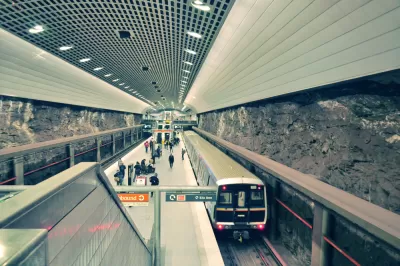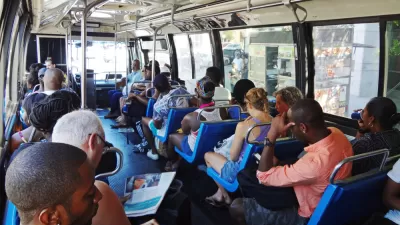After adjusting to COVID-19 protocols and pandemic-era budget cuts, transit agencies must again reorient their service to the post-pandemic world.

Public transit agencies have had it rough for the past year and a half, and as the nation starts to recover from the COVID-19 pandemic, they must adapt yet again to new challenges and opportunities. A blog post from TransitCenter highlights three key challenges and offers solutions for how transit agencies can make the shift to post-pandemic service. "By taking a closer look at these factors, we hope to illuminate the path to successful restoration of service, and shed light on what transit agencies need from their executives, elected officials, and other public agencies in order to provide riders with faster, more reliable trips."
The first challenge is transitioning away from COVID-19 protocols. "As COVID cases drop across much of the United States, transit agencies will need to move away from what is widely seen as 'hygiene theater,' while partnering with public health agencies and other trusted messengers to communicate that transit is safe." The same goes for social distancing rules. "Agencies should advocate for distancing guidelines/requirements on transit to be relaxed in line with falling COVID case rates. States and localities should proactively be adjusting guidelines with both the virus and good transit service in mind."
The third major challenge, the blog asserts, will be hiring and retaining staff. "Widespread operator shortages at agencies across the country have magnified difficulties related to capacity limits" and reduced agencies' ability to provide efficient service. "The need to both expand the pipeline for training and improve pay for transit workers points to the importance of high-level government coordination and securing financial resources to compensate a growing workforce."
FULL STORY: Three Challenges Facing Transit Agencies Emerging From the Pandemic

Alabama: Trump Terminates Settlements for Black Communities Harmed By Raw Sewage
Trump deemed the landmark civil rights agreement “illegal DEI and environmental justice policy.”

Planetizen Federal Action Tracker
A weekly monitor of how Trump’s orders and actions are impacting planners and planning in America.

The 120 Year Old Tiny Home Villages That Sheltered San Francisco’s Earthquake Refugees
More than a century ago, San Francisco mobilized to house thousands of residents displaced by the 1906 earthquake. Could their strategy offer a model for the present?

In Both Crashes and Crime, Public Transportation is Far Safer than Driving
Contrary to popular assumptions, public transportation has far lower crash and crime rates than automobile travel. For safer communities, improve and encourage transit travel.

Report: Zoning Reforms Should Complement Nashville’s Ambitious Transit Plan
Without reform, restrictive zoning codes will limit the impact of the city’s planned transit expansion and could exclude some of the residents who depend on transit the most.

Judge Orders Release of Frozen IRA, IIJA Funding
The decision is a victory for environmental groups who charged that freezing funds for critical infrastructure and disaster response programs caused “real and irreparable harm” to communities.
Urban Design for Planners 1: Software Tools
This six-course series explores essential urban design concepts using open source software and equips planners with the tools they need to participate fully in the urban design process.
Planning for Universal Design
Learn the tools for implementing Universal Design in planning regulations.
Clanton & Associates, Inc.
Jessamine County Fiscal Court
Institute for Housing and Urban Development Studies (IHS)
City of Grandview
Harvard GSD Executive Education
Toledo-Lucas County Plan Commissions
Salt Lake City
NYU Wagner Graduate School of Public Service





























